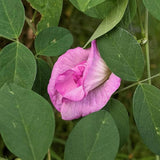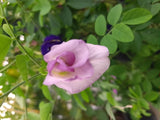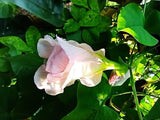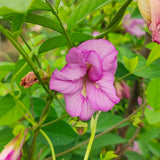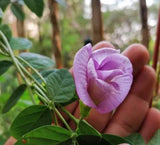🌸 Product Description: Clitoria ternatea “Pink Double”
Unfurl the magic of a rare double‑flowered beauty: Clitoria ternatea “Pink Double” seeds bring you a spectacular twist on the classic butterfly pea vine. Imagine gardens brightened by soft rose‑pink blossoms, each bloom unfolding with double petals—an unexpected floral duet that dances above rich green foliage.
🌱 Botanical & Bloom Details
-
Bloom Color: Rose‑pink double flowers (a rare color mutation from the usual blue/purple or white types).
-
Vine Habit: Fast‑growing perennial vine reaching up to 10–15 ft long, twining elegantly over trellises or cascading in hanging baskets.
-
USDA Hardiness Zones: Zones 9–11 (perennial in frost‑free climates; grown as annual or pot‑culture elsewhere).
-
Hardiness: Tropical/sub‑tropical native; thrives in warm, sunny to partly shaded sites with well‑draining soil.
🌿 Fragrance & Pollinator Power
While the double pink blossoms are not particularly fragrant, their allure lies in their visual drama. These flowers are a magnet for bees, butterflies, moths, and even some beetles—observed visiting for nectar and pollen. The plant supports Papilio demoleus caterpillars and is pollinated by bees like Apis mellifera, Anthophora, and carpenter bees, plus butterflies such as Jamides celeno and Udaspus folus, and even crambid moths like Spoladea recurvalis.
🐝 Wildlife & Ecological Role
-
Pollinator Support: Frequent visits from native bees and butterflies help seed set and garden biodiversity.
-
Larval Host: Acts as a host for some Papilionid and lycaenid butterfly larvae such as Papilio demoleus and Jamides celeno.
🌍 Cultural & Historical Fascination
Known across South‑East Asia as “aprajita” (Sanskrit for “the unconquered”), butterfly pea has adorned rituals, teas, textiles, and cuisines for centuries:
-
Used to create vibrant blue and purple‑hued rice, desserts (like nasi kerabu), and herbal drinks across Malaysia, Thailand, Vietnam, and beyond.
-
Its color‑changing property—transforming blue tea to purple or pink with the addition of lemon or acidity—never fails to astonish guests and gardeners alike.
✨ Interesting Facts
-
The genus name “Clitoria” was inspired by the flower’s shape—an unusual botanical tribute dating back to Linnaeus’s naming in the 18th century.
-
Extracts of C. ternatea contain cyclotides, biologically active peptides with natural insecticidal and repellent properties—nature's own garden protector.
-
In tropical agriculture, it's valued as multipurpose: forage, ground cover, hay crop, green manure, and soil revegetation in disturbed sites.
🌱 How to Grow “Pink Double” Seeds
-
Scarify or nick the seeds and soak overnight for faster germination.
-
Sow ½–1 in deep in warm soil after all frost danger has passed.
-
Provide support for climbing (trellis, fence, or hanging basket).
-
Full sun to partial shade, moderate watering; drought‑tolerant once established.
-
Pinch growing tips to encourage bushiness and continuous bloom.
🌷 Why You’ll Love These Seeds
These seeds offer:
-
Stunning rose‑pink double blooms—rare, romantic, and eye‑catching
-
A garden teeming with beneficial bees, butterflies, and moths
-
Cultural elegance—from Ayurvedic lore to Southeast Asian teas and color‑changing culinary magic
Bring home these delightful seeds and grow more than just flowers—grow stories, color, wildlife, and tradition in your garden with Clitoria ternatea “Pink Double”.






